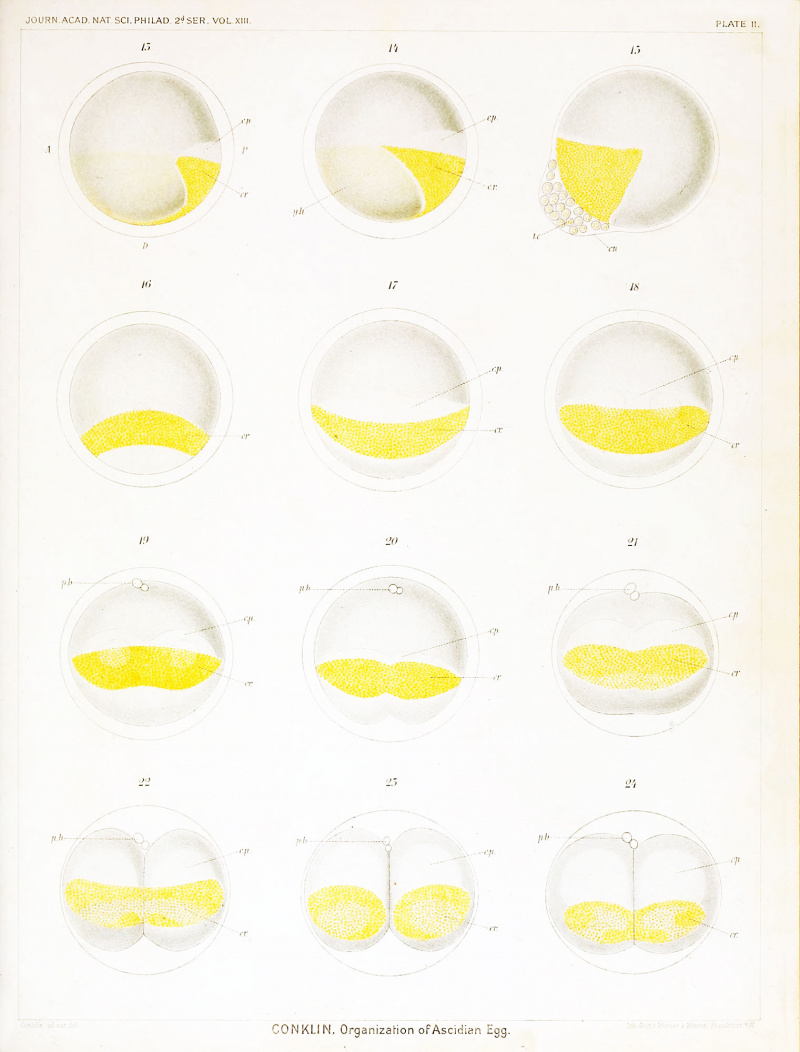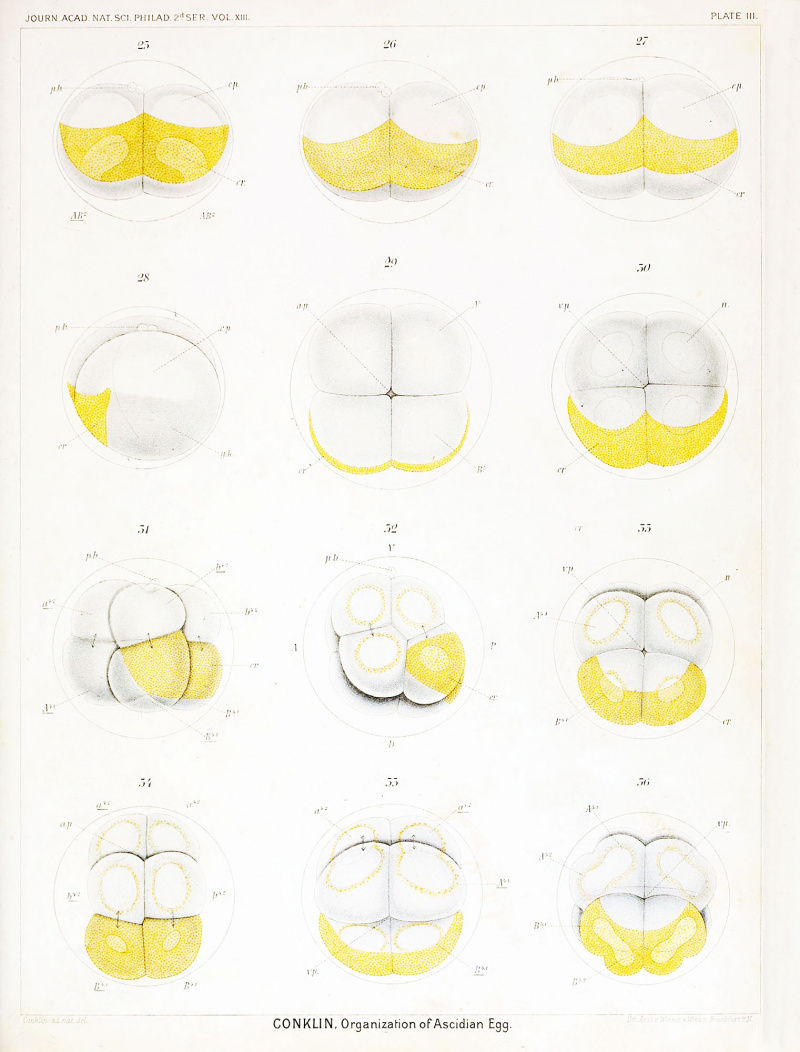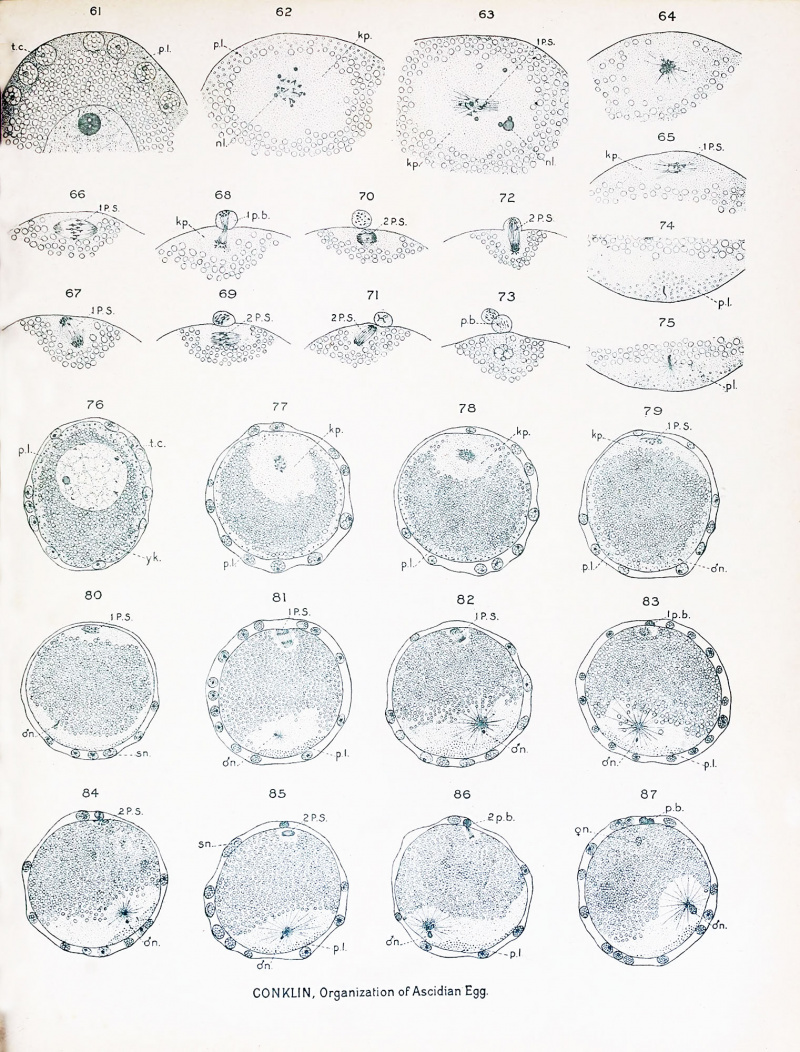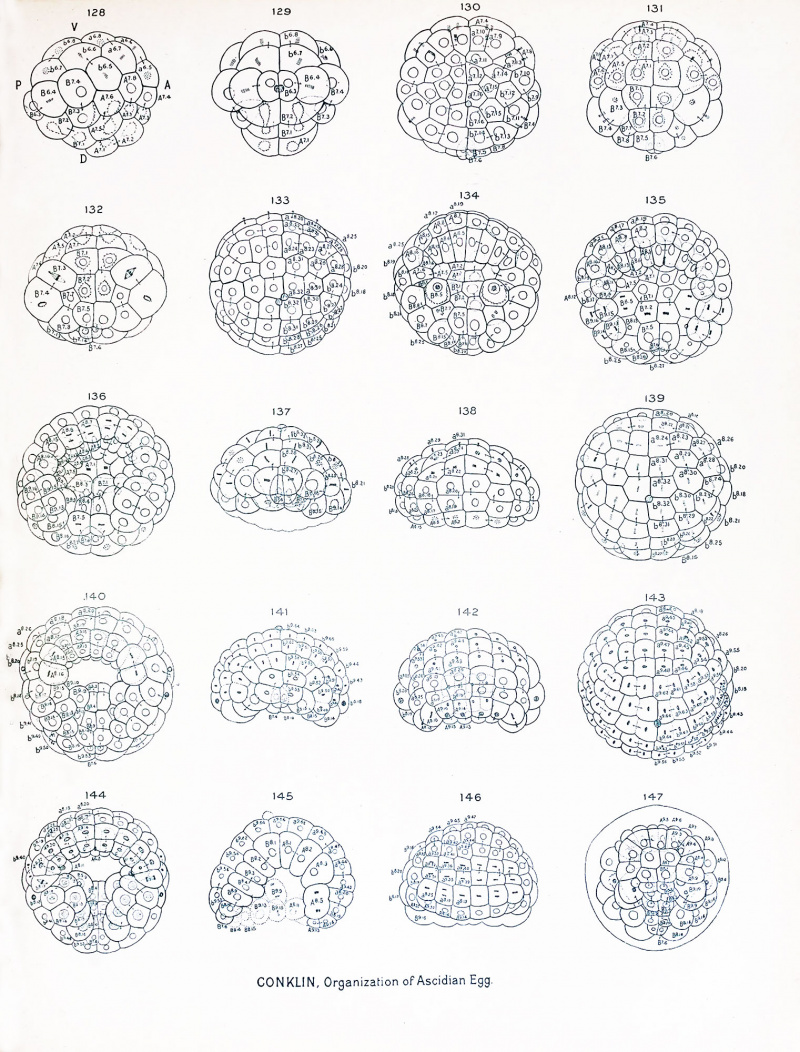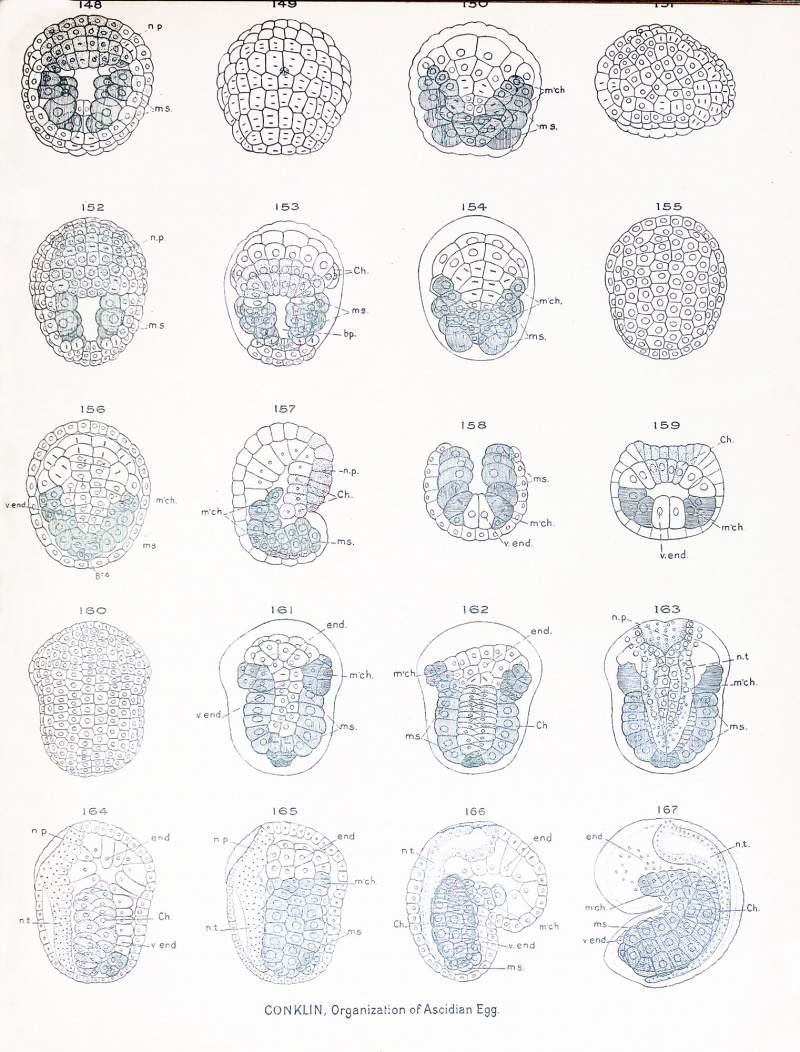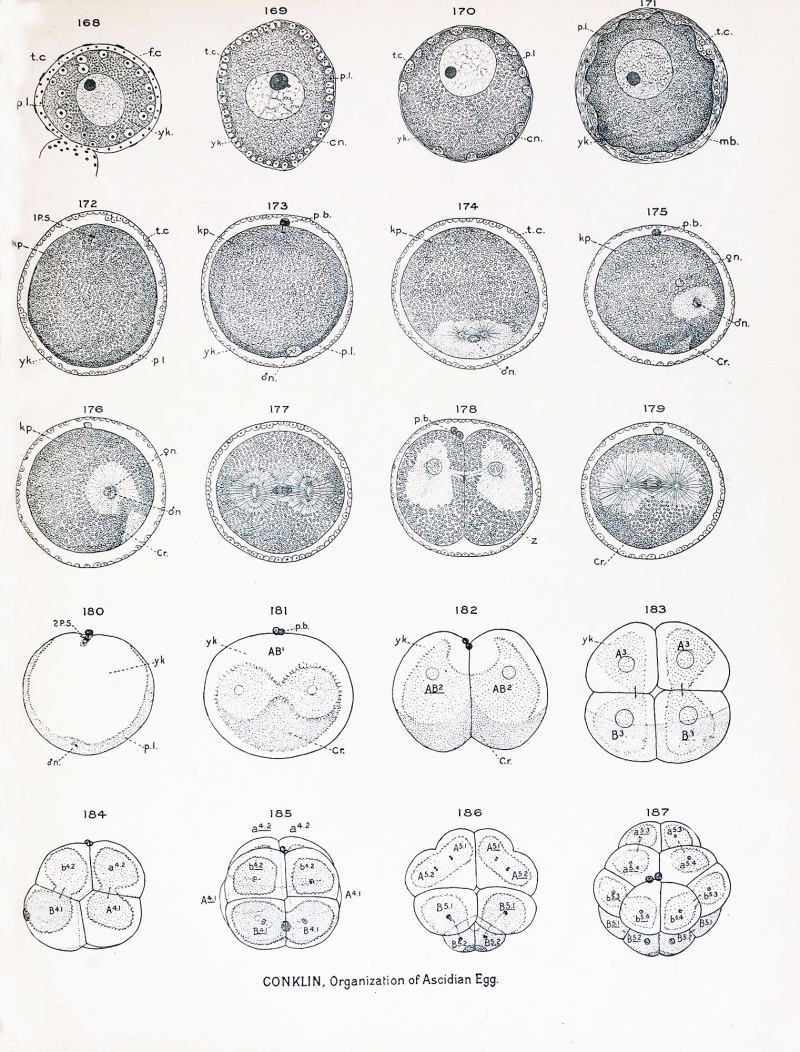Paper - The Organization and Cell-Lineage of the Ascidian Egg 10
| Embryology - 26 Apr 2024 |
|---|
| Google Translate - select your language from the list shown below (this will open a new external page) |
|
العربية | català | 中文 | 中國傳統的 | français | Deutsche | עִברִית | हिंदी | bahasa Indonesia | italiano | 日本語 | 한국어 | မြန်မာ | Pilipino | Polskie | português | ਪੰਜਾਬੀ ਦੇ | Română | русский | Español | Swahili | Svensk | ไทย | Türkçe | اردو | ייִדיש | Tiếng Việt These external translations are automated and may not be accurate. (More? About Translations) |
Conklin EG. The Organization and Cell-Lineage of the Ascidian Egg (1905) J. Acad., Nat. Sci. Phila. 13, 1.
| Historic Disclaimer - information about historic embryology pages |
|---|
| Pages where the terms "Historic" (textbooks, papers, people, recommendations) appear on this site, and sections within pages where this disclaimer appears, indicate that the content and scientific understanding are specific to the time of publication. This means that while some scientific descriptions are still accurate, the terminology and interpretation of the developmental mechanisms reflect the understanding at the time of original publication and those of the preceding periods, these terms, interpretations and recommendations may not reflect our current scientific understanding. (More? Embryology History | Historic Embryology Papers) |
Conklin 1905 TOC: I. The Ovarian Egg | II. Maturation and Fertilization | III. Orientation of Egg and Embryo | IV. Cell-Lineage | V. Later Development | VI. Comparisons with A.mphioxus and Amphibia | VII. The Organization of the Egg | Summary | Literature Cited | Explanation of Figures
Explanation Of Figures
All figures represented in the plates were drawn with the aid of the camera lucida.
Plates I-V represent the living eggs of Oynthia (Styela) partita, and the colors used are in no sense diagrammatic but are as nearly as possible those which appear in life;
Plate VI-X show fixed and stained eggs of the same species; plates XI anil XII, lixed and stained eggs of Citmn hitextintdk. The figures of the living eggs of Cynthia i plates I-V) were drawn at the stage level under Zeiss Apochromatic Obj. 4 mm., Oc. 4. and are therefore magnified 250 diameters. With the exception of figs. 46-49 all the details shown in these drawings were observed in living eggs without reference to fixed and stained material; in the figures specified certain cell outlines were added to the drawings of the living eggs after a study of prepared material.
The figures of plates VI-XII, with the exception of figs. 61-75, were drawn at the stage level under Zeiss Apochromatic Obj. 3 mm., Oc. 4; in the process of reproduction they have been reduced about one-fifth so that as they now appear they represent a magnification of about 266 diameters. Figs. 61-75, plate VI, were drawn under Zeiss Apochromatic Obj. 1.5 nun., Oc. 4, and therefore represent a magnification, after reduction, of about 535 diameters. The chorion and test cells, though present in most of the eggs drawn, have been omitted from all the figures, except those of plates I, VI and VII; the chorion, without the test cells, is shown in plates II-V.
Reference Letters
A. - Anterior.
a.p. - Animal pole.
bp. - Blastopore.
ch. - Chorda
cn. - Chorion.
c. p. - Clear protoplasm.
Cr. - Crescent of mesodermal substance (yellow in Cynthia).
Cr. s, - Substance of crescent.
D. - Dorsal.
end. - Endoderm.
f. c - Follicle cells (outside of chorion).
g. v. - Germinal vesicle.
kp. - Karyoplasm (achromatic substance from nucleus).
mb. - Thick membrane which becomes chorion.
m'ch. - Mesenchyme.
ms. - Muscle cells.
n. - Nucleus.
n. p. - Neural plate.
nl. Nucleolus. n. t. Neural tube.
P. Posterior, p. b. Polar body.
1 p. b. First bolar body.
2 p. b. Second polar body.
p. 1. Peripheral layer of protoplasm.
1 P. S. First polar spindle.
2 P. S. Second polar spindle.
Sn . Spermatozoon.
t. c Test cells.
V. Ventral,
v. end. Ventral (caudal) endoderm.
v. p. Vegetal pole.
y. h. Yellow hemisphere of egg.
yk. Yolk.
z Zwischenkorper (mid-body).
n. Sperm nucleus.
Nomenclature of Cells
A Anterior half of egg; B Posterior half ; AB Right half; AB Left half ; A and A Right and left anterior quadrants; B and B Right and left posterior quadrants.
From the 8-cell stage onward the cells of the eudodermal hemisphere are designated by capital letters, those of the ectodermal hemisphere by lower case. The first exponent indicates the cell generation, counting the unsegmented egg as the first ; the second exponent the position of the cell relative to the animal and vegetal poles, cells which lie nearest the vegetal pole having the lowest exponent, those farthest away (nearest the animal pole) having the highest. See p. 37.
Plate I
Figures of the Living Egg* of Oynthia partita; Maturation and Fertilization.
Fig. 1. Unfertilized egg before the fading of the germinal vehicle, showing central mass of gray yolk, peripheral layer of yellow protoplasm, test cells and chorion.
Fig. 2. .Similar egg after the disappearance of the nuclear membrane, showing the spreading of the clear protoplasm of the germinal vesicle at the animal pole.
Fig. 3. Another egg about five minutes after fertilization, showing the streaming of the peripheral protoplasm to the lower pole where the spermatozoon enters, thus exposing the gray yolk of the upper hemisphere; the test cells are also carried by this streaming to the lower hemisphere.
Figs. 4 and 5. Other eggs -bowing successive stages in the collection of the yellow and clear protoplasm at the vegetal pole; clear protoplasm lies beneath and extends a short distance beyond the edge of the yellow cap.
Figs. 6-10. Successive stages of the same egg drawn at intervals of about five minutes; viewed from the vegetal pole. In fig. 6 the area of yellow protoplasm is smallest, and the sperm nucleus is a small clear area near its center. Figs. 7.-10 show stages in the spreading of this yellow protoplasm until it covers nearly the whole of the lower hemisphere; at the same time the sperm nucleus and aster move toward one side of the yellow cap and the yellow protoplasm begins to collect into a crescent at this side.
Fig. 11. Side view of an egg of about the same stage as fig. 10, showing the eccentric position of the sperm nucleus and a small area of clear protoplasm at the upper pole where the polar bodies are being formed.
Fig. 12. Polyspermic (?) egg, viewed from the vegetal pole, showing four collections of yellow protoplasm around as many sperm (?) nuclei (see p. 24).
Plate II
Living Eggs of Cynthia partita ; First Cleavage.
Figs. 13 and 14. Side views of egg, showing the formation of the crescent (cr.) from the yellow hemisphere ; in all the figures the animal pole is above, the vegetal pole below. Above the
yellow crescent is an area of clear protoplasm (c. p.).
Fig. 15. Similar stage of another egg showing the aggregation of test cells over the crescent and the protrusion of the chorion at this place, an unusual phenomenon.
Fig. 16. Egg showing crescent, viewed nearly from the vegetal pule
Fig. 17. Another egg showing crescent and clear protoplasm, viewed from posterior pole; the animal pole is above, the vegetal below.
Figs. 18, 19, 20. Successive stages of the same egg drawn at intervals of about two minutes, showing the approaching division of the egg.
Figs. 21, 22, 23, 24. Succesive stages in the first cleavage of an egg, drawn at intervals of about two or three minutes. The egg is viewed from the posterior pole and shows the complicated forms taken by the yellow crescent during the division, also the enlargement of the area of clear protoplasm and its extension toward the animal pole.
Plate III
Living Eggs of Oynthia partita; First to Fourth Cleavage.
Figs. 25 and 26. Same egg as the one shown in figs. 21-24; final stages in the first cleavage.
Fig. 27. Another egg at the close of the first cleavage ; seen from the posterior pole.
Fig. 28. End view of egg of same stage as preceding, showing the lateral limits of the yellow crescent, the clear protoplasm in the upper hemisphere and the yolk in the lower. The anterior portion of the lower hemisphere is composed of light gray material ; this is the gray crescent and gives rise to chorda and neural plate.
Fig. 29. Four-cell stage, viewed from the animal pole.
Fig. 30. Similar egg seen from the vegetal pole; the crescent covers about half of the posterior blastomeres.
Fig. 31. Fight-cell stage: the crescent is limited entirely to the two posterior blastomeres at the vegetal pole : while under observation the furrow between B 4' and b 4-2 shifted from the position indicated by the faint line to that shown by the heavy line, thus giving rise to the "cross furrow" shown in the next figure.
Fig. 32. Fight-cell stage, viewed from the right side, showing a small amount of yellow protoplasm around all the nuclei.
Fig. 33. Same stage viewed from the vegetal pole, showing 1% yolk laden endoderm cells and the crescent.
Fig. 34. Same stage viewed from the posterior-animal pole showing the clear ectodermal cells and the crescent.
Fig. 35. Same stage seen from the anterior-vegetal pole; yellow protoplasm around all the nuclei.
Fig. 36. Fourth cleavage of the egg seen from the vegetal pole.
Plate IV
Living Eggs of Cynthia partita ; Fourth Cleavage to Gastrula.
Fig. 37. Sixteen-cell stage viewed from vegetal pole.
Fig. 38. Sixteen-cell stage, from the animal pole, yellow protoplasm around the nuclei.
Fig. 39. Twenty-two cell stage, from the vegetal pole; four mesoderm cells (yellow), ten endoderm, chorda and neural plate cells (gray) and eight ectoderm cells (clear).
Fig. 40. Same stage viewed from the posterior pole.
Fig. 41. Egg passing into the 32-cell stage; postero-dorsal (vegetal pole) view.
Fig. 42. Thirty-two-cell stage, postero-dorsal view.
Fig. 43. Forty-four- cell stage; posterior view, showing separation of mesenchyme (m'ch) from muscle cells (ms.).
Fig. 44. Same stage, dorsal view, showing subdivision of endoderm cells.
Fig. 45. Similar stage, posterior view, showing separation of another mesenchyme cell from a muscle cell.
Fig. 46. Seventy-four cell stage, dorsal view, showing division of 4 chorda and 4 neural piatc cells; there are 10 mesenchyme and 6 muscle cells, besides 10 endoderm cells.
Fig. 47. One hundred and sixteen cell-stage, showing the beginning of gastrulation, also the neural plate, chorda, muscle and mesenchyme cells.
Fig. 48. Slightly older stage showing advancing gastrulation with inrolling of cells at edge of blastopore.
Plate V
Living Embryo of Oynthia partita - Gastrula to Tadpole
Fig. 49. Gastrula showing neural plate, chorda and muscle cells; about 176 cells, 96 ectoderm, 32 mesoderm, 20 endoderm, 8 chorda, 8 dorsal neural plate and 12 ventral neural plate cells.
Figs. 50 and 51. Two stages of one embryo, the second drawn about ten minutes after the first; the yellow cells in the mid-line (m'ch.) are mesenchyme cells, the others (ms.) muscle cells.
Fig. 52. Posterior view of elongated gastrula, the blastopore reduced to a narrow slit.
Fig. 53. Dorsal view of similar stage, the blastopore a small opening at the posterior end of a groove
Fig. 54. An older embryo, the blastopore covered by the forward growth of the posterior lips.
Fig. 55. Embryo with inrolling neural plate and with muscle cells arranged in three rows.
Fig. 56. Embryo of about the same stage as that shown in figs. 52 and 53; seen from the left side showing neural groove, three rows of muscle cells which run transversely to the long axis, and a row of mesenchyme cells in the long axis.
Fig. 57. Embryo viewed from posterior end, showing blastopore-raphe with open groove above and with three rows of muscle cells on each side, also a row of mesenchyme cells.
Fig. 58. Young tadpole seen from dorsal side, neural groove open in front and closed behind, smallcelled mesenchyme in front of large muscle cells.
Fig. 59. Same stage as preceding seen from the right side, showing neural groove, mesenchyme and three rows of muscle, cells.
Fig. 60. Tadpole of slightly older stage viewed from the posterior (caudal) end showing on each side three large muscle cells each of which belongs to a row of such cells (cf Fig. 59). These muscle cells are connected across the mid-line at the posterior end by a few small mesenchyme cells.
Plate VI
Sectionsof Eggs of Cynthia partita; Maturation and Fertilization.
Figs. 61-75 magnified 535 diameters; Figs. 76-87 magnified 266 diameters.
Fig. 61. Ovarian egg fully formed, showing germinal vesicle surrounded by yolk, and peripheral layer of protoplasm containing test cells and yellow granules (small spheres in figure).
Fig. 62. Free egg shortly after the dissolution of the nuclear membrane, showing in the middle of the clear karyoplasm fragments of nucleolus, chromosomes and a granular mass from which spindle fibres arise; the peripheral protoplasm contains yellow granules.
Fig. 63. Egg similar to the preceding, but with the spindle fibres more fully formed.
Fig. 64. Similar to preceding, spindle fibres radiate in all directions.
Fig. 65. The first polar spindle lies near the surface of the egg and its fibres are approximately paratangential ; the peripheral layer of protoplasm has streamed away from the animal pole and the karyoplasm from the germinal vesicle has spread out here in a broad disk.
Fig. 66. Metaphase of first polar spindle which is nearly parallel with surface; no centrosomes present.
Fig. 67. Anaphase of first polar spindle which is turning into a radial position.
Fig. 68. Separation of first polar body.
Fig. 69. Metaphase of second polar spindle, which is paratangential in position.
Fig. 70. Anaphase of second polar spindle.
Fig. 71. Second polar spindle approaching a. radial position.
Fig. 72. Separation of second polar body.
Fig. 73. Fusion of chromosomal vesicles in egg to form egg nucleus.
Fig. 74. Vegetal pole of egg of the stage shown in figs. 65 and 79, showing the entrance of the sperm into the egg and the collection of yellow granules around the sperm head.
Fig. 75. Later stage in the entrance of the sperm ; formation of sperm aster from the middle- piece.
Fig. 76. Free egg before the solution of the nuclear membrane but after the extrusion of the test cells; the chromosomes at the periphery of the germinal vesicle.
Fig. 77. Egg after being laid but before fertilization ; chromosomes and granular substance which forms spindle fibres in the center of the karyoplasm. The egg remains in this condition until fertilized.
Fig. 78. Same as preceding, save that spindle fibres are forming and karyoplasm has moved nearer to the animal pole.
Fig. 79. Egg showing the entrance of the spermatozoon near the vegetal pole and the spreading of the karyoplasm into a thin cap at the animal pole.
Fig. 80. Slightly more advanced stage showing development of sperm aster and collection of yellow granules at vegetal pole, spermatozoa have entered some of the test cells.
Fig. 81. First polar spindle assuming a radial position ; increase of cytoplasmic area surrounding the sperm nucleus and aster, the latter are moving across the egg axis and hence in the longest path toward the equator.
Fig. 82. Stage slightly more advanced than the preceding; sperm nucleus, aster, clear and yellow protoplasm becoming eccentric toward the posterior side.
Fig. 83. First polar body formed ; prophase of second polar spindle.
Fig. 84. Metaphase of second polar spindle; yellow protoplasm collecting into crescent.
Fig. 85. Anaphase of second polar spindle, spermatozoa in some of the test cells.
Fig. 86. Telophase of second polar spindle.
Fig. 87. Movement of sperm nucleus and aster and of surrounding protoplasm to the posterior side of the egg; approach of the germ nuclei.
Plate VII
Sections of Eggs of Cynthia partita; Fertilization and Early Cleavages.
FFig. 88. Division of sperm aster ; crescent substance at periphery on posterior side.
Fig. 89. Similar to preceding but showing egg nucleus.
Figs. 90 and 91. Sections at right angles to first cleavage plane but oblique to egg axis, showing the union of pronuclei; clear and yellow protoplasm and sperm amphiaster in posterior half of egg.
Fig. 92. Section in the plane of the first cleavage (future median plane) showing the union of the germ nuclei, the clear protoplasm and crescent on the posterior side of the egg, and the polar bodies above.
Fig. 93. Early prophase of the first cleavage, in the plane of the spindle axis.
Fig. 94 and 95. Two dispermic eggs; the first showing two sperm nuclei on the posterior side of the egg with a single crescent ; the second, two sperm nuclei and one egg nucleus, with the clear protoplasm and crescent about equally divided, by a tongue of yolk, between the two sperm nuclei.
Fig. 96. Section in the plane of the first cleavage and transverse to the spindle, showing a cross section of the equatorial plate near the middle of the egg, surrounded by clear protoplasm, also the crescent at the posterior border with some of the yellow spherules all around the spindle.
Fig. 97. Metaphase of the first cleavage; equatorial section at right angles to the preceding.
Figs. 98 and 99. Early and late anaphases of the first cleavage; sections in equatorial plane.
Fig. 99. Constriction of cell body; chromosomal vesicles at the ends of the nuclear spindle. In both figures the daughter centrosi is are elongating in the equatorial plane and at right angles to the first spindle axis.
Fig. 100. Telophase of the first cleavage, showing the rotation of nuclei, eentrosomes and cytoplasm toward the animal pole of the egg.
Fig. 101. Equatorial section, prophase of second cleavage; crescent substance at the posterior pole.
Fig. 102. Section at right angles to the preceding and through the axis of one of the spindles; nucleus and cytoplasm lie above the equator, yolk and crescent below.
Fig. 103. Equatorial section showing precocious division of the eentrosomes in one of the blastomeres.
Fig. 104. Anaphase of second cleavage; equatorial section ; chromosomal vesicles at ends of nuclear spindles.
Fig. 105. Telophase of second cleavage ; equatorial section, showing the bending of the middle of the spindle toward the center of the egg, and a large amount of clear cytoplasm aud of crescent substance in the posterior quadrants.
Figs. 106 and 107. Two sections through one and the same egg in the eight-cell stage ; the first through the anterior blastomeres ; the second through the posterior. The cytoplasm is most abundant in the cells at the animal pole, the crescent substance in the two posteriorvegetal cells, though it is also found around all the nuclei. The polar bodies, which are shown in stippled outlines, are not in the plane of either of these sections, but in the region between them.
Plate VIII
Surface Views of Entire Eggs of Cynthia partita; Eight to Forty-four Cells.
g. 108. Eight-cell stage ; left side of egg ; showing spindles of third cleavage.
Fig. 109. Anterior view of 8-cell stage, showing cytoplasm most abundant in the animal pole cells, and the yolk largely collected in the anterior cell of the vegetal hemisphere.
Figs. 110, 111,112. Stages in the fourth cleavage; figs. 110 and 112 viewed from the animal pole, fig. Ill from the. vegetal pole.
Fig. 113. Telophase of fourth cleavage, vegetal poje view ; caps of deeply staining protoplasm lie at the hinder borders of the small posterior cells (B 5,2 ).
Figs. 114 and 115. Anterior and posterior views of the 16-cell -stage; fig. 115 showing caps of deeply staining protoplasm at the posterior pole, which later go into the posterior mesenchyme cells (B' 6 , figs. 130, 131).
Figs, 116 and 117. Ventral and dorsal views of a 20-cell stage, showing the cells at the vegetal pole dividing before those at the animal pole.
Fig. 118. Slightly older stage with some of the animal pole cells dividing.
Figs. 119-123. Five views of one and the same egg; fig. 119, ventral; 120, dorsal; 121, anterior; 122, posterior; 123, right side; the latter shows in dotted outlines the great elongation of the cells at the animal pole and the flattened shape of the cells at the vegetal pole ; all the designations of cells in tig. 123 should be underscored ; 44 cells, 16 ectoderm, 10 endoderm, 10 mesoderm, 4 chorda and 4 neural plate cells.
Figs. 124-129. Six different views of one and the same egg in the 44-cell stage showing the divisions of the ectodermal cells and the second cells of the crescent (B 6 ' 4 ) ; when these divisions are completed there will be 62 cells. Fig. 124, ventral; 125, dorsal; 126, anterior; 127, postero-dorsal.
Plate IX
Surface Views of Entire Eggs of Cynthia partita; Forty-four to Tiro Hundred and Eighteen Cells,
Figs. 128, 129. Same egg as shown in figs. 124-127. Fig. 128 from the left side; the equator of the egg (plane of the third cleavage) is the heavy line running between A ami 1' and separating cells designated by lower case from those designated by capital letters. Fig. 129. View from the posterior pole.
Figs. 130 and 131. Ventral and dorsal views respectively of one and the same egg; 64 cells, 32 in each hemisphere, distributed as follows: Ventral hemisphere, 26 ectoderm, 6 neural plate cells (a 7 -', a 7 -', a 7- ' 3 ) ; Dorsal hemisphere, 10 endoderra, 4 chorda (A 73 , A 77 ), 4 neural plate (A'-, A 7 - 8 ), 10 mesenchyme (B 7 - 6 , B 7 5 , B", B 73 , A 7 ' 6 ) and 4 muscle (B 78 , B 7 ->).
Fig. 132. Postero-dorsal view of an egg in the same stage as the preceding showing direction of division of mesenchyme cell (B 73 ).
Figs. 133 and 134. Ventral and dorsal views respectively of one and the same egg; 110 cells; Ventral hemisphere 64 cells, 52 ectoderm, 12 neural plate (a 8 ' 9 , a 8= , a 8 ' 7 , a 8 ' 8 , a 8,25 , a 8=6 ) ; Dorsal hemisphere 46 cells, 10 endoderm, 8 chorda (A 85 , A 86 , A 8 - 13 , A 8 ' 4 ), 8 neural plate (A 8 - 7 , A 8 - 8 , A 8 -' 3 , A 8 ' 6 ), 12 mesenchyme (B 7 - 6 , B", B 7 7 , B 8 ', B 86 , A 7 - 6 ), 8 muscle (B 8 - 7 , B 88 , B 8 ' 5 , B 8 " 6 ). Gastrulation has begun.
Fig. 135. Dorsal view of a slightly more advanced stage showing increasing gastrulation ; 118 cells, ventral hemisphere 64 cells, dorsal hemisphere 54, viz., 10 endoderm, 16 mesenchyme, 12 muscle, 8 chorda, 8 neural plate; when the divisions indicated by spindles are completed there will 4 additional endoderm and 2 additional mesenchyme cells.
Figs. 136-139. Four views of one and the same egg; fig. 136 dorsal, 137 posterior, 138 anterior, 139 ventral; gastrulation well advanced. 124 cells; Ventral hemisphere 64 cells, 52 ectoderm, 12 neural plate (a 8 -'", a 8 -*", a 8 " 7 , a 8 ' 8 , a 8 - 23 , a 6 - 56 ); Dorsal hemisphere 60 cells, 14 endoderm, 8 chorda, 8 neural plate, 18 mesenchyme, 12 muscle. Spindles are already present for divisions, which, when completed, will lead to 178 cells, viz., 96 ectoderm, 12 neural plate of ventral hemisphere, 12 neural plate of dorsal hemisphere, 8 chorda. 211 mesenchyme, 12 muscle, 18 endoderm.
Figs. 140-143. Four views of one and the same egg; 140 dorsal, 141 posterior, 142 anterior, 143 ventral. Gastrulation is here far advanced. 180 cells; Ventral hemisphere 108 cells, 96 ectoderm, 12 neural plate; Dorsal hemisphere 72 cells, 12 neural plate of dorsal hemisphere, 8 chorda, 20 mesenchyme. 12 muscle, 20 endoderm; when the divisions indicated by spindles are completed there will be 4 additional neural plate cells.
Figs. 144 and 145. Two views of the same egg; 144 dorsal, 145 median optical section in sagittal plane. In fig. 145 the polar body is not visible, but its supposed position is indicated by the dotted outline at the animal pole; the dotted outlines at the lower pole indicate the mesoderm cells which lie in the lateral lip of the blastopore and out of the plane of the section ; the rolling in of the muscle cells in the lateral lips is well shown.
Fig. 146. Anterior view of an egg of about the same stage as the preceding, showing the division of the 12 neural plate cells of the ventral hemisphere.
Fig. 147. Ventral view of a similar stage with the ectoderm omitted in order to show the endoderm and mesoderm from the ventral side. At this stag.' all the ectoderm cells have passed into the 9th generation, all the endoderm into the 8th or 9th, all the mesoderm except IV" into the 8th or 9th, all the chorda and neural plate cells into the 9th. There are 218 cells; Ventral hemisphere 128 cells, 104 ectoderm, 24 neural plate of ventral hemisphere; Dorsal hemisphere 90 cells, viz., 16 mural plate, 16 chorda, 20 mesenchyme, 12 muscle, 26 endoderm.
Plate X
Entire Embryos of Cynthia partita; Gastrula to Tadpole.
Muscle cells shaded by vertical lines, mesenchyme by transverse line*, nerve plate and tube by fine stipples, chorda by coarse stipples.
Figs. 148-151. Four view? of the same embryo; fig. 14.8 dorsal, 149 ventral -posterior, 150 same view but deeper level, showing mesoderm and endoderm, 151 right side. Many of the ectoderm cells are passing into the 10th generation.
Figs. 152-154. Three views of : embryo ; fig. 152 dorsal, showing closure of the blastopore from in front, 153 same view but deeper level, showing cells beneath the ectoderm, 154 ventral view of mesoderm and endoderm below ectoderm.
Figs. 155 and 156. Two ventral views of an advanced gastrula, the first showing the superficial ectoderm, the latter the endoderm and mesoderm lying beneath the ectoderm.
Fig. 157. Left side of embryo, showing, in optical section, muscle cells, mesenchyme, chorda and nerve plate.
Figs. 158 and 159. Two optical sections of the same embryo, the former (158) through the open blastopore at the posterior end of the embryo, the latter (159) through the region anterior to the blastopore.
Figs. 160-162. Three views of the same embryo from the ventral side but drawn at different levels; 160 surface view showing ectoderm ; 161 same view deeper level, showing mesoderm and endoderm : 162 same view still deeper level, showing chorda, mesoderm and endoderm.
Fig. 163. Dorsal view of embryo of same stage as preceding showing nerve plate and tube, mesoderm and chorda.
Figs. 164 and 165. Two views of same embryo from right side ; fig. 164 median optical section showing chorda, nerve tube and endoderm ; 165 more superficial view showing muscle cells and mesenchyme.
Fig. 166. Older embryo from right side, showing in optical section nerve tube, chorda, mesoderm and endoderm.
Fig. 167. Young tadpole from left side showing in optical section nerve tube, chorda and mesoderm.
Plate XI
Eggs of Ciona intestinalis ; Ovocyte to Fourth Cleavage.
Figs. 168-179 actual section*; figs. 180-187 whole eggs. Crescent substance and clear protoplasm stippled. Polar bodies are actually present where drawn.
Fig. 168. Half grown ovarian egg, showing test cells within the egg cytoplasm, which is composed of a layer of yolk surrounding the nucleus and a peripheral layer of clear protoplasm ; around the whole egg is a layer of small follicle cells which later develop into the very large conical cells which surround the chorion.
Fig. 169. Older ovarian egg, showing the area of the yolk increased and the test cells limited to the peripheral layer of protoplasm, which is sharply differentiated from the yolk.
Fig. 170. Still older ovarian egg, showing the test cells arranged in groups or "nests" at the periphery of the egg.
Fig. 171. Ripe ovarian egg ready to escape from the ovary, showing the extrusion of the test cells and the formation of a thick homogeneous membrane around the egg, which ultimately becomes the chorion.
Fig. 172. Free hut unfertilized egg which lias shrunken away from the chorion, showing the first maturation spindle, the peripheral layer of protoplasm collected over the lower pole of the egg and the achromatic substance of the germinal vesicle (kp) spread in a broad layer over the upper pole and around the central yolk.
Fig. 173. Extrusion of first polar body and entrance of spermatozoon ; the sperm nucleus lies in the peripheral layer surrounded by clear protoplasm in which astral rays are developing.
Fig. 174. Nearly equatorial section of the egg showing sperm nucleus and amphiaster at the posterior side of the egg; at the surface is the granular protoplasm of the peripheral layer.
Fig. 175. Section of egg in plane of first cleavage (median plane), showing the approach of the germ nuclei and the movement of the peripheral layer of protoplasm from the lower pole to the posterior side to form the crescent ; in the darkly staining substance of the crescent is a clear triangular area which corresponds to the clear area surrounding the sperm nucleus in fig. 173.
Fig. 176. Section of slightly older stage in plane of first cleavage, showing the union of the germ nuclei ; polar body out of the plane of section.
Fig. 177. Anaphase of first cleavage, showing the complete separateness of the nuclear and astral portions of the mitotic figure; the crescent substance shows at the ends of the spindle.
Fig, 178. Telophase of first cleavage, showing " zwischenkorper " (z), also the bending of spindle axis and shifting of cytoplasm and nuclei toward the animal pole.
Fig. 179. Anaphase of second cleavage, showing separateness of nuclear and astral portions of mitotic figure, also position of crescent on postero- dorsal side ; polar body out of the plane of section.
Fig. 180. Entire egg of Ciona, showing formation of second polar spindle, peripheral layer of protoplasm, sperm nucleus and aster.
Fig. 181. Anaphase of first cleavage viewed from posterior pole.
Fig. 182. Two-cell stage seen from posterior pole, cytoplasm and nuclei lie near animal pole, crescent near vegetal, fig. 183. Four-cell -stage seen from vegetal pole ; the crescent covers about one half the surface of the two posterior blastomeres.
Fig. 1S4. Eight cell-stage, left side, showing cap of deeply staining protoplasm at posterior pole of cells (B 4-1 ), which later goes into the posterior mesenchyme cells (B 7 ' J , fig. 200.)
Fig. 185. Eight cells, posterior view; spindles of the fourth cleavage present.
Fig. 186. Fourth cleavage, vegetal pole.
Fig. 187. Fourth cleavage, animal pole; 16 cell.-.
Plate XII
Whole Eggs of Ciona intestinalis ; Sixteen Cells to Gastrula.
Crescent substance stippled in nil the figures; clear protoplasm also stippled in figs. 188-191. Pobty bodies are actually present where drawn.
Fig. 188. Sixteen cell stage, anterior pole.
Fig. 189. Sixteen cells seen from vegetal pole; all but two of the cells are passing from the 5th to the 6th generation.
Fig. 190. Similar stage viewed from animal pole.
Fig. 191. Animal pole view, 5th to the 6th generation; 20 cells; when the divisions are completed, which are here indicated by spindles, there will be 32 cells.
Figs. 192-195. One and the same egg in the 32-cell-stage. Fig. 192. From animal pole. Fig. 193. From vegetal pole, spindles present in many of the cells, which are about to pass into the 7th generation. Fig. 194. From posterior pole; all nuclei at the animal pole in a resting condition. Fig. 195. Antero-vegetal view.
Figs. 196 and 197. One and the same egg seen from the animal (ventral) and from the vegetal (dorsal) poles; most of the cells at the vegetal pole have just passed into the 7th generation ; spindles are present in all the cells at the animal pole preparatory to their division into the 7th generation ; 44 cells, 20 of the 6th and 24 of the 7th generation.
Figs. 198-204. With the exception of fig. 199, all these figures represent views of one and the same egg. Fig. 198. View from animal pole showing all the ectoderm cells in process of division. Fig. 199. Another egg of the same stage as the preceding, but seen from a more anterior point of view. Fig. 200. Vegetal pole showing all the cells at this pole in a resting condition. Fig. 201. Same egg seen from a more anterior point of view. Fig. 202. Same egg viewed from the anterior pole. Fig. 203. Viewed from the right side showing in dotted outline the great elongation of the cells of the vegetal pole and a corresponding flattening of the cells at the animal pole. Fig. 204. Viewed from the posterior pole. 76 cells, viz., 32 ectoderm, !< endoderm, 18 mesoderm, 8 chorda, 8 neural plate; when the divisions indicated in the ectoderm cells are completed there will be 64 ectoderm cells and 108 cells in all.
Fig. 205. Gastrula corresponding in stage to fig. 140 of the Cynthia egg; 178 cells, vis., 108 ectoderm and neural plate (ventral), 20 endoderm, 18 mesenchyme, 12 muscle, 8 chorda, 12 neural plate (dorsal).
Fig. 206 and 207. Older gastrula with blastopore much restricted by the growth of the anterior lip Fig. 206. View of superficial ectoderm and mesoderm. Fig. 2(17. Deeper view of same embryo showing endoderm and mesoderm.
Conklin 1905 TOC: I. The Ovarian Egg | II. Maturation and Fertilization | III. Orientation of Egg and Embryo | IV. Cell-Lineage | V. Later Development | VI. Comparisons with A.mphioxus and Amphibia | VII. The Organization of the Egg | Summary | Literature Cited | Explanation of Figures
Conklin EG. The Organization and Cell-Lineage of the Ascidian Egg (1905) J. Acad., Nat. Sci. Phila. 13, 1.
Cite this page: Hill, M.A. (2024, April 26) Embryology Paper - The Organization and Cell-Lineage of the Ascidian Egg 10. Retrieved from https://embryology.med.unsw.edu.au/embryology/index.php/Paper_-_The_Organization_and_Cell-Lineage_of_the_Ascidian_Egg_10
- © Dr Mark Hill 2024, UNSW Embryology ISBN: 978 0 7334 2609 4 - UNSW CRICOS Provider Code No. 00098G


